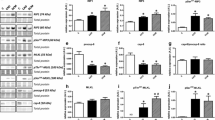Abstract
Dysregulated expression of lysosomal cysteine cathepsins is associated with adverse cardiac remodeling, a characteristic of several cardiovascular diseases. However, the information regarding the role of cysteine cathepsin L (CTSL) and cathepsin B (CTSB) in dilated cardiomyopathy (DCM) is limited. The present study was aimed to investigate the expression of CTSL and CTSB in animal model of doxorubicin (doxo)-induced cardiomyopathy as well as in peripheral blood samples of DCM patients. Cardiac tissue sections from doxo-treated and control rats were used to study the expression of CTSL and CTSB by enzyme assay and immunohistochemistry (IHC). Peripheral blood mononuclear cells (PBMCs) isolated from DCM patients (n = 29) along with age-matched healthy controls (n = 28) were used to assay enzymatic activity of these cathepsins. Activities of these proteases were further correlated with echocardiographic parameters of DCM patients. A significant increase in CTSL activity and protein expression was observed with no changes in CTSB levels in doxo-treated rats as compared to controls. We also observed a drastic increase in the functional activity of cathepsin L+cathepsin B (CTSL+B), CTSL, and CTSB in DCM patients compared to controls (p ≤ 0.001). Increased levels of these proteases exhibited a statistically significant correlation with reduced left ventricular ejection fraction (LVEF) in DCM patients (ρ = −0.58, p = 0.01). For the first time, this study demonstrates a correlation between increased expression of CTSL and CTSB in PBMCs with severity of left ventricular dysfunction in DCM patients. Thus, these proteases may serve as blood-based biomarker of DCM and prove useful in its management.




Similar content being viewed by others
References
Jefferies JL, Towbin JA (2010) Dilated cardiomyopathy. Lancet 375(9716):752–762
Towbin JA, Bowles NE (2002) The failing heart. Nature 415(6868):227–233
Taylor MR, Carniel E, Mestroni L (2006). Cardiomyopathy, familial dilated. Orphanet J Rare Dis 1(1):1
Mestroni L, Maisch B, McKenna WJ et al (1999) Guidelines for the study of familial dilated cardiomyopathies. Eur Heart J 20(2):93–102
Afonso L, Mohammad T, Thatai D (2007) Crack whips the heart: a review of the cardiovascular toxicity of Cocaine. Am J Cardiol 100(6):1040–1043
Klatsky AL (2009) Alcohol and cardiovascular diseases. Expert Rev Cardiovasc Ther 7(5):499–506
Jordan MA (2002) Mechanism of action of antitumor drugs that interact with microtubules and tubulin. Curr Med Chem Anticancer Agents 2(1):1–7
Takemura G, Fujiwara H (2007) Doxorubicin-induced cardiomyopathy from the cardiotoxic mechanisms to management. Prog Cardiovasc Dis 49(5):330–352
Chatterjee K, Zhang J, Honbo N et al (2010) Doxorubicin cardiomyopathy. Cardiology 115(2):155–162
Carvalho FS, Burgeiro A, Garcia R et al (2014) Doxorubicin-induced cardiotoxicity: from bioenergetic failure and cell death to cardiomyopathy. Med Res Rev 34(1):106–135
Lefrak EA, Pitha J, Rosenheim S et al (1973) A clinicopathologic analysis of adriamycin cardiotoxicity. Cancer 32(2):302–314
Cheng XW, Shi GP, Kuzuya M et al (2012) Role for cysteine protease cathepsins in heart disease focus on biology and mechanisms with clinical implication. Circulation 125(12):1551–1562
Muller AL, Dhalla NS (2012) Role of various proteases in cardiac remodeling and progression of heart failure. Heart Fail Rev 17(3):395–409
Turk B, Turk D, Turk V (2000) Lysosomal cysteine proteases: more than scavengers. BBA Protein Struct Mol Enzymol 1477(1–2):98–111
Turk B, Turk V, Turk D (1996) Structural and functional aspects of papain-like cysteine proteinases and their protein inhibitors. Biol Chem 378(3–4):141–150
Turk B, Turk D, Salvesen GS (2002) Regulating cysteine protease activity: essential role of protease inhibitors as guardians and regulators. Curr Pharm Des 8(18):1623–1637
Stypmann J, Glaser K, Roth W et al (2002) Dilated cardiomyopathy in mice deficient for the lysosomal cysteine peptidase cathepsin L. Proc Natl Acad Sci USA 99(9):6234–6239
Ge J, Zhao G, Chen R et al (2006) Enhanced myocardial cathepsin B expression in patients with dilated cardiomyopathy. Eur J Heart Fail 8(3):284–289
Zhao G, Li Y, Cui L et al (2015) Increased circulating cathepsin K in patients with chronic heart failure. PLoS ONE 10(8):e0136093
Liu Y, Li X, Peng D et al (2009) Usefulness of serum cathepsin L as an independent biomarker in patients with coronary heart disease. Am J Cardiol 103(4):476–481
Krishnamurthy B, Rani N, Bharti S et al (2015) Febuxostat ameliorates doxorubicin-induced cardiotoxicity in rats. Chem Biol Interact 237:96–103
Schwartzkopff B, Fassbach M, Pelzer B et al (2002) Elevated serum markers of collagen degradation in patients with mild to moderate dilated cardiomyopathy. Eur J Heart Fail 4(4):439–444
Yu XH, Zhang XG, Li SJ, et al (2005) [The expression and significance of myocardial cathepsin L in dilated cardiomyopathy]. Zhonghua nei ke za zhi 44(7):495–498
Arola OJ, Saraste A, Pulkki K et al (2000) Acute doxorubicin cardiotoxicity involves cardiomyocyte apoptosis. Cancer Res 60(7):1789–1792
Acknowledgements
Department of Biotechnology (DBT), Govt. of India (BT/PR7146/MED/30/900/12), New Delhi, India, financially supported this study. Siddharth Mehra is a recipient of Senior Research Fellowship from University Grants Commission (U.G.C), New Delhi, India. The authors like to acknowledge Dr. Anurag Kumar and Dr. Prajwal for their help in formatting the final version of manuscript.
Author information
Authors and Affiliations
Corresponding author
Ethics declarations
Conflict of interest
The authors declared that they have no potential conflicts of interest.
Research involving human participants
All procedures performed in studies involving human participants were in accordance with the ethical standards of the 1964 Helsinki declaration and was approved by medical ethics review board of All India Institute of Medical Sciences, New Delhi, India.
Informed consent
Written informed consent was obtained from all the participants before enrollment. Similarly for the use of animal model in the present study all applicable international, national, and institutional guidelines for the proper care and use of animals were followed.
Rights and permissions
About this article
Cite this article
Mehra, S., Kumar, M., Manchanda, M. et al. Clinical significance of cathepsin L and cathepsin B in dilated cardiomyopathy. Mol Cell Biochem 428, 139–147 (2017). https://doi.org/10.1007/s11010-016-2924-6
Received:
Accepted:
Published:
Issue Date:
DOI: https://doi.org/10.1007/s11010-016-2924-6




